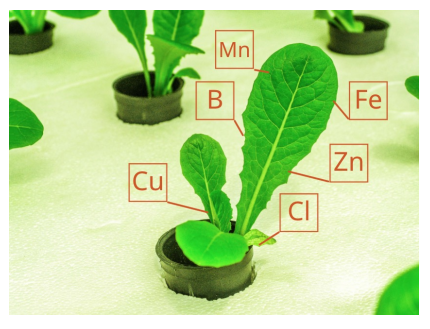Detailed guidance on micronutrients
In the previous section, we took a closer look at the different macronutrients that plants need and the symptoms plants exhibit in the lack of these nutrients. In this section, we’ll take a look at the micronutrients.
The micronutrients are the “salt and pepper” of plant food. Plants can possibly live without these micronutrients, but they will suffer (think about eating your food without any seasoning—bleh).
Most micronutrients share a similar function in the growth of plants. They mostly participate in synthesizing the structure and function of plant cells.
The typical micronutrients are Boron (B), Chlorine (Cl), Copper (Cu), Manganese (Mn), Iron (Fe), and Zinc (Zn). Zinc and Iron are particularly important in the enzymes associated with energy provision in photosynthesis.

Here are the symptoms your plants will exhibit when the micronutrients are lacking:
1. Iron
A distinct yellowing between the leaf veins, which stay green. This will often be observed on new growth and younger leaves.
2. Chlorine
Absence will cause the leaves to wilt. They will become yellowed and necrotic, eventually turning into a bronze color.
3. Manganese
Initially, you will observe an interveinal yellowing in both younger and older leaves, depending on plant types. Brown, dry areas may develop in the leaves, and the leaves may drop.
4. Boron
Plant size is usually reduced, and the growing point may die back. The root tips will often become swollen and discolored, the leaves will thicken and become brittle, and they may curl and develop yellow spotting.
5. Zinc
Plants will remain short, with a reduction in internode length and leaf size. Leaf edges may also be distorted or puckered, and you will observe yellowing between the leaf veins.
6. Copper
Copper deficiency is rare, but when it occurs, you will notice young leaves becoming dark green and twisted, often with brown, dry spots.

Below is a table with a brief summary of the nutrients and their function in plants:

Please note that the percentage of plant is not the percentage of nutrients in the plant food, so the percentage of nutrients in LYKO plant food is different.
All these nutrients are crucial to plant development, and this is the reason mixing your own nutrient solution can get tricky—you need to be deeply familiar with the amount of nutrients your plants need.
The LYKO system and the nutrient solutions that come with each system is designed to give your plants all the nutrients it needs. All you need to remember is to add the solutions in correct proportion (Plant A: Plant B: Water = 5mL: 5mL: 1000mL). As long as you remember this, your plants will be in good shape.
